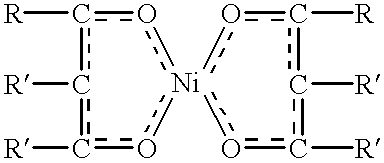Dimerized alcohol compositions and biodegradible surfactants made therefrom having cold water detergency
a biodegradable surfactant and composition technology, applied in detergent compounding agents, other chemical processes, liquid soaps, etc., can solve the problems of undesirable oligomerization process, poor biodegradability of branched poor biodegradability of long chain alcohol sulfonates, etc., to achieve good cold water detergency
- Summary
- Abstract
- Description
- Claims
- Application Information
AI Technical Summary
Benefits of technology
Problems solved by technology
Method used
Image
Examples
example 1
This example demonstrates the manufacture of a dimerized monobranched C.sub.12 -C.sub.15 alcohol from internal olefins using a nickel chelate catalyst.
A flask was charged with 2268.7 grams of a C.sub.6 -C.sub.8 internal olefins having some 4, 5, 9, and 10 carbon olefins, and distilled using an 11 plate Oldershaw distillation column with a swinging bucket reflux splitter condenser, a dry ice chilled trap, and a nitrogen blanket. After about 37 hours of distillation, those cuts distilling up to 138.degree. C. in the pot and 125.degree. C. at the head were collected for a total amount of about 1200 grams. These cuts represent the light ends of the olefin, C.sub.4 -.sub.8.
The 1200 grams of the C.sub.4-8 olefin feed was dimerized by the following method. The 1200 grams of the olefin was poured into a 51 round bottom flask equipped with a condensor, a dry ice condenser, a thermocouple, a water bath, and a nitrogen blanket. About 19.74 g of dried nickel hexafluoroacetoacetyl acetonate (nic...
example 2
This example demonstrates the preparation of a C.sub.13-17 dimerized monobranched alcohol from internal olefins using a nickel carboxylate catalyst.
The same procedure as used in Example 1 above was followed with the following noted exceptions. The amount of C.sub.4-10 internal olefins distilled was 2427.7 grams. 712.5 grams of distillate boiling at 120 to 154.degree. C. in the pot and 89.degree. C. to 129.degree. C. at the head were collected. The reflux was set at 5 seconds on, and 7 seconds off. The distillate cuts were predominantly C.sub.6-9 carbon chain internal olefins. 702.6 grams of these olefins were dimerized in a 2 liter flask using 0.493 g of nickel 2-ethylhexanoate-tirfluoroacetate in 5 ml of cyclohexane and 12 ml of a 1 molar solution of ethylaluminum dichloride in hexane, (first batch of catalyst) as the dimerization catalysts injected into the olefin. The contents of the flask were heated to 35-38.degree. C. on average throughout the course of the reaction. After abo...
example 3
This example demonstrates the preparation of a C.sub.13,15,17 dimerized monobranched alcohols from alpha olefins.
In this example, a mixture of 600 g NEODENE.RTM. 6 .alpha.-olefin, a C.sub.6 olefin, and 800 g of NEODENE.RTM. 8 .alpha.-olefin, a C.sub.8 olefin, containing 5.32 g of ethylaluminum dichloride, were added to a 5 liter flask. The same procedure as used in example 1 was followed with the following differences. A solution of 7.9 g of the nickel 2-ethylhexanoate-tirfluoroacetate in 6.35 g of cyclohexane (the nickel solution) was added and heated. The flask was maintained at from 33.degree. C. to 38.degree. C. throughout the course of the reaction. Another 7.6 ml of the aluminum solution as prepared in example 2 and 5 ml of the nickel solution were injected into the reaction flask after about 8 hours of heating.
About 1.5 liters of the sodium citrate neutralizing solution was used to neutralize the dimerized olefins, separated, and again repeated. The dimerized product was dist...
PUM
| Property | Measurement | Unit |
|---|---|---|
| Fraction | aaaaa | aaaaa |
| Fraction | aaaaa | aaaaa |
| Fraction | aaaaa | aaaaa |
Abstract
Description
Claims
Application Information
 Login to View More
Login to View More - R&D
- Intellectual Property
- Life Sciences
- Materials
- Tech Scout
- Unparalleled Data Quality
- Higher Quality Content
- 60% Fewer Hallucinations
Browse by: Latest US Patents, China's latest patents, Technical Efficacy Thesaurus, Application Domain, Technology Topic, Popular Technical Reports.
© 2025 PatSnap. All rights reserved.Legal|Privacy policy|Modern Slavery Act Transparency Statement|Sitemap|About US| Contact US: help@patsnap.com

